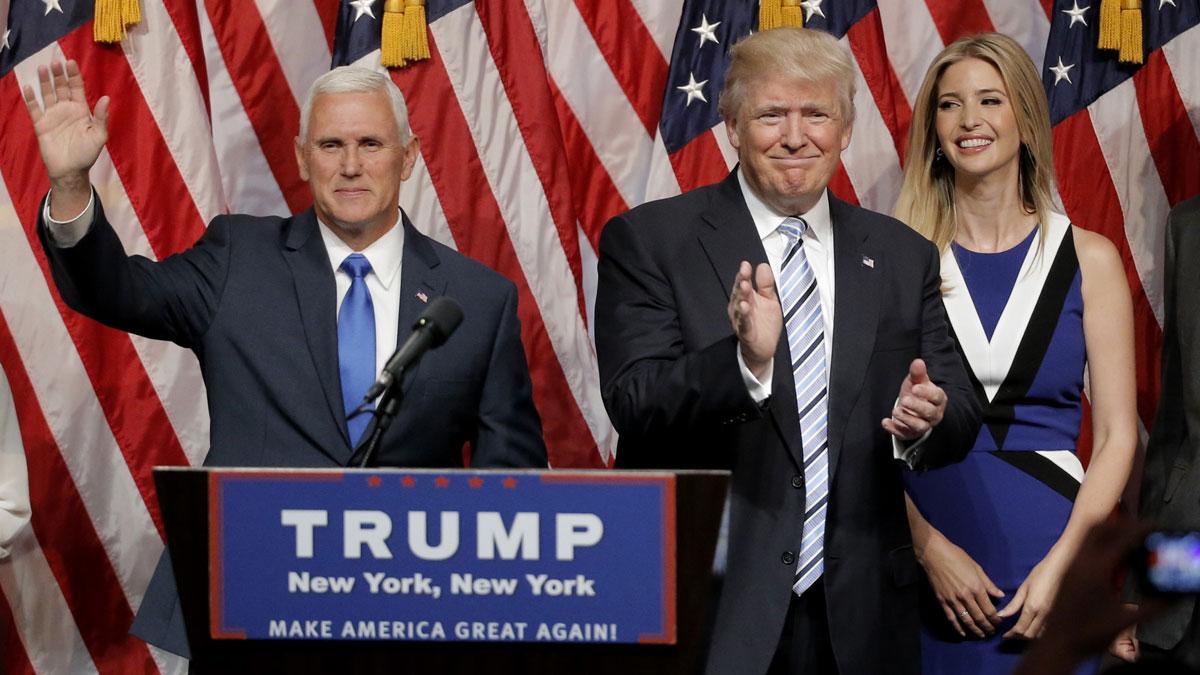In Ohio, some liberals fear Trump’s persistent appeal
Republican presidential candidate Donald Trump applauds Saturday after introducing Indiana Governor Mike Pence as his vice presidential running mate.
Ohio is a perennial presidential battleground state, and Republicans are acutely aware of this as they host their party's national convention there this week.
So are Democrats. Hillary Clinton and her super PAC allies have run more than 8,500 television ads there since June 8, according to a Center for Public Integrity review of data provided by ad tracking firm Kantar Media/CMAG. That's an average of about one ad every six minutes since Clinton clinched her party's presidential nomination.
With the exception of Florida, no other state has seen so many ads since the primaries ended.
Democratic state Sen. Capri Cafaro, who represents an area of northeastern Ohio outside of Cleveland, is concerned that Republican nominee Donald Trump is more appealing to Rust Belt voters than Clinton is. An average of recent polls in the state helps support this notion: it currently gives Clinton less than a two-point lead over Trump.
The Center for Public Integrity recently caught up with Cafaro to talk about her qualms about Clinton, why Trump is winning over many Ohioans and the role of super PACs in the 2016 election.
This interview has been edited for length and clarity.
Center for Public Integrity: How competitive do you think Donald Trump will be in Ohio?
Capri Cafaro: Very. One of the reasons he’s gotten so far is because there is a general frustration by the electorate that they are sick of career politicians. People have come to the Rust Belt for the last 20, 30-plus years and promised X, Y, Z as far as an economic resurrection. But no one has really reflected the anger and the frustration of these people. That’s where I think Trump really has a competitive advantage.
Look at the primary results. Basically every single county from Lake Erie all the way down to West Virginia, from Ashtabula to Gallia County, all went for Trump. There’s a good reason for that. He didn’t win because Republicans voted for him. He won because Democrats voted for him. There are a lot of disenfranchised Reagan Democrats who may cross over for Trump in battleground states like Ohio.
What do you think about Hillary Clinton as the Democratic nominee in 2016?
I’m very open about my reservations in regards to Secretary Clinton. Frankly, I would have preferred [Vice President] Joe Biden. I feel that she’s certainly capable of doing the job, but she, in my view, is not a perfect candidate.
What weaknesses do you think she has?
She has weaknesses in regards to relatability, in regards to trustworthiness. It seems as if she is more focused on becoming president of the United States because she wants to be president of the United States, not necessarily because she wants to serve the people of the United States. However, I am a Democrat and a Democrat for a reason. And there is a lot at stake in this election — issues like Supreme Court vacancies, the protection of reproductive rights and the continuation of the Affordable Care Act.
What’s your take on the role super PACs are playing in 2016?
I have general disdain for both super PACs and Citizens United. What has come of politics is greatly fueled by the glut of money that has entered, particularly post-Citizens United.
What lessons do you think Democrats should learn from the proliferation of super PACs?
In order to compete, people are going to have to play by the rules that exist. Obviously, Bernie Sanders has done an incredible job raising low-dollar donations at a high volume, which we saw Barack Obama do, which we saw Howard Dean do. But it’s possible [super PACs will continue to be embraced], unless there is significant campaign finance reform.
There is a bill pending in Congress to limit the amount of time one spends raising money, which I think is fantastic. The fact that members of Congress spend more time raising money than they do, you know, actually doing their job — in order to keep their job — there’s something obviously, distinctly wrong with that.
Some people have proposed getting rid of contribution limits to ease politicians’ fundraising pressure. How would things be different if you could ask for checks of unlimited amounts?
Our contribution limit is like $12,500, okay? That’s a pretty high individual contribution limit. In a place like Ohio, I don’t necessarily know how many people you could just call upon to get $12,500. It could have some kind of an impact, but as with super PACs, it creates an inherent discrepancy between those that have networks of people who can write huge checks and those that can’t.
What do you find most striking about an election between Clinton and Trump?
Both Hillary Clinton and Donald Trump have been known by the American public for 25, 30 years. How are either of them going to move the needle with just ads, or tweets, or anything else? People’s minds are pretty made up. How do you redefine yourself? How do you re-introduce yourself to the American public when you’re already engrained in the American consciousness?
This story is part of Buying of the President 2016. Tracking the candidates, political committees and nonprofits that are making this presidential election the most expensive in history. Click here to read more stories in this investigation. Or sign up for the Center for Public Integrity's Watchdog email.
Copyright 2016 The Center for Public Integrity. This story was published by The Center for Public Integrity, a nonprofit, nonpartisan investigative news organization in Washington, D.C.
Our coverage reaches millions each week, but only a small fraction of listeners contribute to sustain our program. We still need 224 more people to donate $100 or $10/monthly to unlock our $67,000 match. Will you help us get there today?
